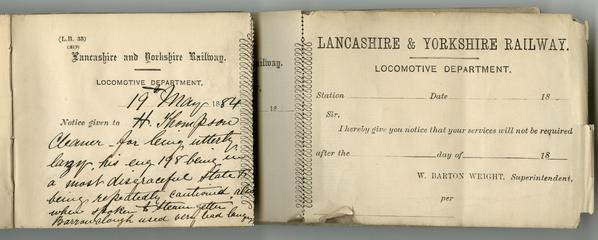


Bronze bust of William Stuart
1855

Publicity poster "The Swedish National Railway Museum" showing 1 electric and 2 steam locos around a turntable
1984

Monogram, Lancashire & Yorkshire Railway

Model railway carriage
1894

Lancashire & Yorkshire Railway Signalling School Model Railway Layout
1912

North of Ireland via Fleetwood & Belfast
circa 1920

Lantern Lectures

Cheap excursions to York, Whitby, Bridlington, Scarborough. Filey & Harrogate
1856

Stone sculpture from Berry Brow Station

Notices of dismissal
1883-1910

Beautiful Bray

the explosives act
1911

Southport for Mild Winters.
circa 1920

Model, railway layout, Lancashire & Yorkshire Railway Signalling School
1912

L&YR locomotive, number 1008
1889

Lancashire & Yorkshire Railway locomotive, Wren
1887

Lancashire & Yorkshire Railway Carriage and Wagon guard books
1880-1908
Lancashire & Yorkshire Railway bell
Signal lever frame board
Telegraph block bell
Telegraph block instrument, Lancashire & Yorkshire Railway
Telegraph block instrument, Lancashire & Yorkshire Railway
Telegraph instrument
Cast iron boundary marker, Great Northern Railway / Lancashire and Yorkshire Railway from Ingrow
circa 1847-1922
Cast iron boundary marker Lancashire & Yorkshire Railway/Great Northern Railway
circa 1847-1922
Lancashire & Yorkshire Railway Signalling School Model Railway Layout
1912
Lancashire & Yorkshire Railway Signalling School Model Railway Layout
1912
Lancashire & Yorkshire Railway Signalling School Model Railway Layout
1912
Lancashire & Yorkshire Railway Signalling School Model Railway Layout
1912
Lancashire & Yorkshire Railway Signalling School Model Railway Layout
1912
Lancashire & Yorkshire Railway Signalling School Model Railway Layout
1912
Lancashire & Yorkshire Railway Signalling School Model Railway Layout
1912
Lancashire & Yorkshire Railway Signalling School Model Railway Layout
1912
Lancashire & Yorkshire Railway Signalling School Model Railway Layout
1912
Lancashire & Yorkshire Railway Signalling School Model Railway Layout
1912
Lancashire & Yorkshire Railway Signalling School Model Railway Layout
1912
Lancashire & Yorkshire Railway Signalling School Model Railway Layout
1912
Lancashire & Yorkshire Railway Signalling School Model Railway Layout
1912
Lancashire & Yorkshire Railway Signalling School Model Railway Layout
1912
Lancashire & Yorkshire Railway Signalling School Model Railway Layout
1912
Lancashire & Yorkshire Railway Signalling School Model Railway Layout
1912
Lancashire & Yorkshire Railway Signalling School Model Railway Layout
1912
Lancashire & Yorkshire Railway Signalling School Model Railway Layout
1912
Lancashire & Yorkshire Railway Signalling School Model Railway Layout
1912
Lancashire & Yorkshire Railway Signalling School Model Railway Layout
1912
Lancashire & Yorkshire Railway Signalling School Model Railway Layout
1912
Lancashire & Yorkshire Railway Signalling School Model Railway Layout
1912
Lancashire & Yorkshire Railway Signalling School Model Railway Layout
1912
Lancashire & Yorkshire Railway Signalling School Model Railway Layout
1912